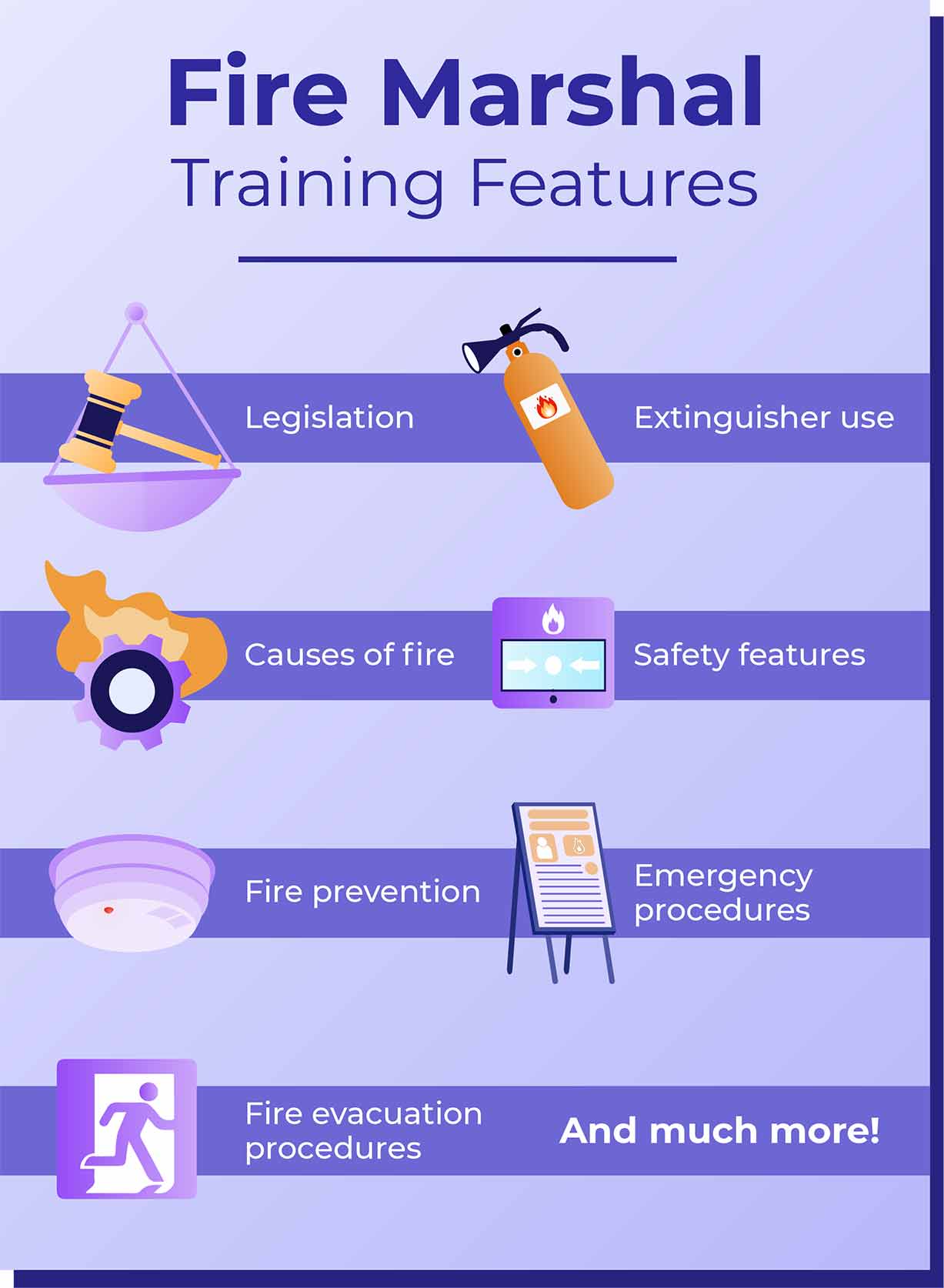Who is Responsible for Fire Safety in the Workplace?
Fire safety in the workplace can be a daunting responsibility for anyone. However, it is a critical aspect of health and safety management. Each year, there are around 22,000 workplace fires in the UK, so they are not an uncommon occurrence. In addition to it being your legal obligation, understanding who is responsible for fire safety in the workplace, legal obligations, fire risk assessment, and how to implement fire safety measures effectively can prevent the devastating consequences of workplace fires.
As is the case with health and safety, a good starting point is finding out who is responsible. Broadly, fire safety is a shared responsibility among employers, employees and the fire services. Each party's role is equally as important as the last.
Importance of Fire Safety in the Workplace
Fire safety is important for a myriad of reasons. It is all-encompassing. By actively addressing fire safety, you protect lives, property and business continuity. The potential impacts of neglecting fire safety include:
- Injury.
- Loss of life.
- Extensive damage to property.
- Long-term financial losses.
- Legal action.
- Disruption of operations.
- Reputational harm.
It’s not just the fire itself; it can be the beginning of a chain reaction of events that can negatively affect the workplace and everyone working there. Fire damages can lead to financial ruin for a business and the loss of jobs. 80% of businesses that experience a major fire fail within 18 months of the incident.
Legal Responsibilities
Employers Duties
In the UK, employers have a legal duty to ensure fire safety in the workplace. Non-compliance with fire safety regulations can result in severe penalties, including fines and imprisonment. If you're responsible for a building, it’s important to do all you can to reduce the risk of fire to keep people safe. Employers must carry out (and review consistently) a fire safety risk assessment to identify the potential for fire to occur in the workplace and cause harm to employees and persons in or around the premises.
The key pieces of fire safety in the workplace legislation are:
- The Health and Safety at Work Act 1974: The Health and Safety at Work etc Act 1974 is the primary piece of legislation covering occupational health and safety in Great Britain.
- Fire Safety Order 2005: Legislation in England and Wales that replaced a raft of former fire safety laws as there were about 70 different laws that covered different aspects of fire safety.
It’s important to note that Scotland and Northern Ireland have separate fire safety regulations. For health and safety obligations you must ensure the safety of your employees so far as is reasonably practical. You must also implement control measures aimed at avoiding or reducing any risks identified in your risk assessment.
Legislation also specifies that you should provide clear, appropriate information and instruction with appropriate training where necessary, such as the NEBOSH Certificate in Fire Safety. You must provide information to employees and anyone else working on your premises, such as:
- Contractors.
- Subcontractors.
- Visitors.
Employee’s Duties
Unless they have a specified role, such as Fire Marshal, the fire safety legal requirements of employees in the workplace are pretty simple. Although it’s simple, in the grand scheme, the role of an employee in workplace fire safety is equally important as that of the employer.
In the event of a fire, employees must not put others in danger, and they must follow the procedures they have been briefed about. They must also inform the ‘responsible person’ of potential fire hazards that may not have been identified. These safety protocols and the reporting of hazards are extremely important as they contribute to the greater whole and assist those with specific fire safety roles in keeping the workplace safe.
Key Roles in Fire Safety
Fire Marshal / Fire Warden
Fire Wardens and Fire Marshals are people designated by a workplace manager with the responsibility to assist them in implementing the necessary fire safety arrangements identified by the manager to prevent a fire from endangering the health and safety of occupants and other relevant persons for whom a duty of care is held.
These individuals play a very important role in preparing a workplace for fire emergencies and identifying risks early. Along with the fire safety and emergency plan, devised by the employer, Fire Marshals are an important risk control measure to help in the event of a fire. The larger an organisation, the more marshals are needed to coordinate evacuations, etc. They need to direct everyone to leave the workplace should an emergency occur, check all accessible spaces in their area to ensure everyone has been evacuated. Whilst doing this they need to close windows and doors behind them to isolate any spread of fire. They should liaise with emergency services on arrival at the premises, informing them of any relevant details relayed to the fire incident and following any instructions provided.
Fire marshal training typically involves some additional courses covering a variety of areas, including legislation, causes of fire, fire prevention, fire evacuation procedures, extinguisher use, safety features, emergency procedures, role and responsibilities, fire assembly, and managing people under pressure. These fire marshal training topics are covered extensively in the NEBOSH Certificate in Fire Safety as well as our Fire Warden course.

Management and Supervisors
Supervisors and management are to make sure fire safety measures are implemented and followed by everyone involved. They must also provide the necessary training and resources for fire wardens and employees to complete their roles and cooperate with the procedures set in place by the employers.
Fire Risk Assessments
Fire risk assessment is crucial to the fire safety process, you unable to correct and control what you’re not aware of. These risk assessments are performed by the qualified person of responsibility to find potential fire hazards and risks in a building or area.
A fire risk assessment includes identifying what could potentially cause a fire and control measures to reduce the risk of a fire occurring. This may include installing sprinklers or smoke detectors and making changes to wiring, appliances, and storage areas. They are conducted at any time of the year and should be done regularly as part of any routine inspections.
The government recommends that risk assessments should be carried out by suitably competent fire professionals. This Fire Risk Assessor is competent at the prescribed level and can carry out a fire risk assessment of a premises. Many assessors work as specialists in a very particular sector, such as hospitals, construction sites, manufacturing, etc., but they also have a very broad understanding of different industries as well.
Creating a Fire Safety Plan
A fire safety plan is a document that details all aspects of fire prevention procedures, evacuation procedures and policies for responding to a fire. Fire safety plans provide guidance so that everyone knows what to do to minimise damage caused by fires. It’s a requirement for any building.
Fire safety plans are a collaborative process between employees and organisational occupational health and safety professionals. A successful plan begins with a thorough fire risk assessment.
Identifying Risks and Hazards
The number and type of hazards will vary from place to place and sector to sector. However, there are some common hazards that you can identify, and mitigate against.

- Electrical Equipment: Overloaded circuits, lack of maintenance can cause equipment to become faulty. Make sure all electrical work is carried out by qualified electricians and ensure that all portable appliance testing (PAT) is up to date.
- Heating / Cooking Appliances: For cooking appliances, keep things clean. A build-up of materials can catch fire. Take care if wearing loose clothing, and NEVER leave cooking unattended. For heaters, keep them away from clothes, curtains and furniture and never use them for drying clothes.
- Inappropriate Storage of Combustible Materials: Empty bins regularly and keep evacuation routes clear of any flammable materials.
- Flammable Liquid Storage: Glues and other solvents are another source of fires as they are likely to combust if not stored correctly.
- Smoking: Keep designated smoking areas away from the building and provide proper ash bins for disposal near these areas.
Emergency Evacuation Procedures
After your risk assessment, if a fire does occur, it’s vital you set out clear evacuation routes and procedures in your fire safety plan. You need to ensure that everyone in the premises can evacuate in timely and safely manner. Your fire safety plan should detail escape routes, emergency procedures, and designated assembly areas. It’s essential you brief new employees on this process as soon as they enter the business and make sure to perform fire drills on a regular basis so everyone can practice evacuating calmly and safely.
Designate roles for specific employees in case of an emergency - tasks such as taking attendance, liaising between fire officials and employees etc.
Compliance with Fire Safety Regulations
There are key fire safety regulations that are there to protect lives – ensuring all equipment and procedures comply with current standards. In 1997, the Fire Precautions (Workplace) Regulations were introduced requiring business that did not need a fire certificate to conduct a fire risk assessment. These regulations broadly brought UK legislation into line with much of Europe.
However, this was then unified under The Regulatory Reform (Fire Safety) Order 2005 (FSO), which is the main legislation governing fire safety in buildings in England and Wales today.
The FSO applies to all workplaces and the common parts of buildings containing 2 or more domestic premises. It places legal duties on anyone in control of these premises (usually the owner or landlord) to carry out and record a fire risk assessment and put in place and maintain general fire precautions.
In response to the Grenfell Tower fire in 2017 - the Fire Safety Act 2021 clarified that the external walls, flat entrance doors, and structures of buildings are all covered by the FSO and must be accounted for in fire risk assessments.
For compliance, you must ensure all equipment and procedures comply with current standards. Check fire alarms, fire extinguishers and fire doors regularly.
Conclusion
To summarise, fire safety is a shared responsibility of everyone on the premises. It requires everyone to do their part and take proactive steps in fire safety management. A great way of investing in this is by enrolling on a course such as the NEBOSH Certificate in Fire Safety. This qualification is recognised as the essential fire safety risk management qualification. As health and safety regulations continue to become more stringent, having qualified individuals in the subject will help you protect lives and the continuity of your organisation.

Real Life Stories



